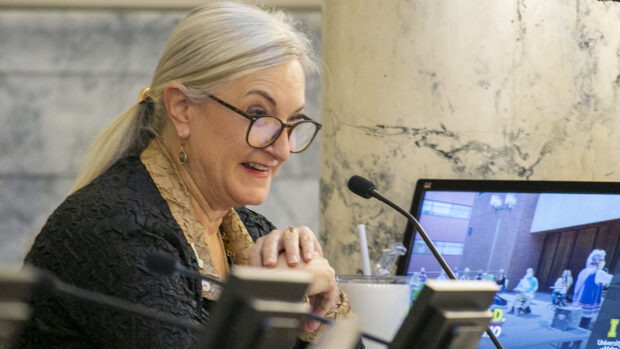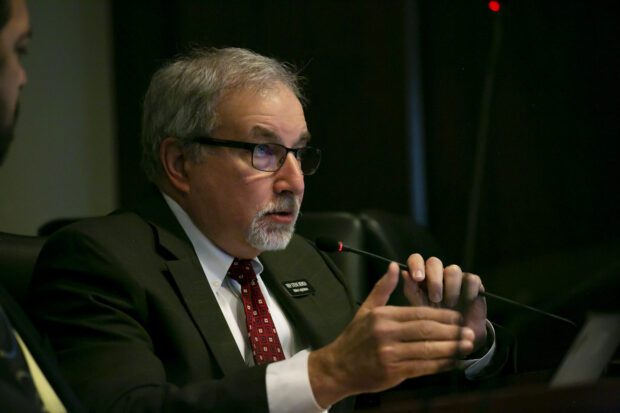We really don’t know what shape our school buildings are in. Or if we’re spending enough on upkeep.
A new and damning state report is a tale of neglect. Because state officials have long treated school construction and maintenance as a local responsibility, they haven’t bothered with basic oversight and process. They’ve gotten careless with 46 million square feet of school buildings, carrying a replacement cost well into the billions of dollars.
And if lawmakers didn’t know the problem they’ve created, they do now. The state’s Office of Performance Evaluations made it all painfully obvious.
Ten senators — the entire Senate Education Committee, and Senate Pro Tem Chuck Winder — came at the issue with a good question. Is Idaho’s tried-and-true method of bankrolling schools with local money becoming obsolete?
“The ability to fund school facilities through bonds may be breaking down,” the senators wrote in a March 5, 2021 letter, requesting an OPE report. “Some communities are growing so fast that they are faced with the challenge of repeatedly going back to the taxpayers for more bonding authority. Other, often rural communities with no or slow growth have very aged school facilities.”
Fair enough. And no neglect of a serious matter here.
But as the OPE report reveals, the overall condition of Idaho’s schools is an unanswerable question.
For one thing, lawmakers haven’t asked for a statewide assessment of school buildings since 1993. Not a single current legislator was in office at the time. That report found $1.3 billion in unmet needs. Nearly three decades later, this number is at best a frame of reference, but more likely, it’s an irrelevant factoid.
So OPE set out to get a more current picture, surveying local district officials. Seventy-seven of the state’s 115 districts responded — and described nearly two-thirds of their building space as being in “fair” or “poor” condition. OPE estimated that it would cost $847 million to get these schools to “good” condition. But in a presentation to lawmakers Monday, OPE senior evaluator Casey Petti cautioned against basing any policy on the report’s rough estimates.
Technically, state law requires districts to file a 10-year building maintenance plan, and a five-year update. But as OPE learned, only 33 districts filed any paperwork between 2016 and 2020. Some districts filed short memos; others filed detailed reports.
And somehow, it gets worse. The districts have no financial incentive to file a report, and they can blow off this legal requirement without any penalty. And when districts actually do email a report to the state Office of School Safety and Security, nothing happens.
“They just sit there,” Petti told the Joint Legislative Oversight Committee Monday.
Lawmakers were dumbfounded.

“Wow, this is really disconcerting,” said Rep. Caroline Nilsson Troy, R-Genesee.
OPE did have some recommendations for the Legislature — and given the current mess, none of them are earthshaking:
- Lawmakers should consider commissioning a new statewide buildings assessment.
- Lawmakers should either scrap the required 10-year district building plans, or come up with a way to actually put them to use. OPE also suggested the reports shouldn’t go to the Office of School Safety and Security — an agency in charge of school security training and safety inspections, not building maintenance.
OPE also couldn’t answer another basic question the senators posed 11 months ago: Is it tougher for districts to pass the bond issues they need to build and repair schools, when most of them also go to voters for supplemental property tax levies?
The numbers suggest it’s easier for a school district to pass a bond issue when it doesn’t have a supplemental levy on the books. But Petti cautioned against drawing conclusions from a small sample size; over the past decade. Schools have run 120 bond issues, and only nine of these elections took place in districts without a supplemental levy.
And here’s the bottom line: only 49 of those 120 bond issues received the two-thirds supermajority needed to pass.
All of this leads to an inevitable and old policy question. Should Idaho do more, at the state level, to build new schools and keep aging schools in good repair?

At the end of Monday’s JLOC meeting, Rep. Steve Berch, D-Boise, did not hide years of impatience.
He said state leaders have never taken seriously a 2005 Supreme Court ruling, which deemed Idaho’s school funding plan unconstitutional. They have lulled themselves into thinking that evergreen supplemental school levies should be the norm. And, Berch said, the 2022 Legislature made matters worse by passing a $600 million income tax cut, taking money off the table that could have been spent on schools.
Now, Berch said, it’s time for Gov. Brad Little to step up and set the tone for the Legislature. “It’s going to take leadership from a central location in government to drive this. I just don’t see 105 people figuring out how to solve this problem.”
Little’s formal, three-paragraph response to the 77-page OPE report was shy on details, but not short on political positioning. “The record investments we are making in education, including committing a significant amount of funding toward deferred maintenance in our schools, will go a long way to address the need.”
This reads like a talking point from a re-election campaign speech, but ultimately, Little is only defending the status quo. That “significant amount of funding” comes to $31.6 million from the lottery and $1.1 million from the state’s general fund, to help districts meet some of their building maintenance requirements. (Since 2006, districts have been required to spend 2% of their building replacement costs on maintenance, using local and state money to do the job. OPE questioned whether this 2% maintenance plan was adequate.)
Little acknowledged the need for a “firm understanding” of the state of Idaho’s school buildings. But his response didn’t address the OPE’s most stinging findings: the unread district maintenance plans, the 29-year (and counting) lapse since Idaho’s last statewide building assessment.
Those basic signs of neglect are years in the making.
Kevin Richert writes a weekly analysis on education policy and education politics. Look for his stories each Thursday.
